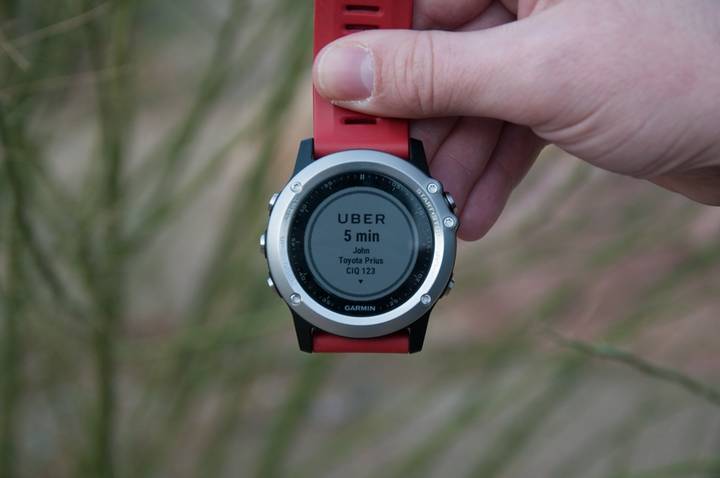Thoughts on GoPro’s new Fusion 360° 5.2K camera
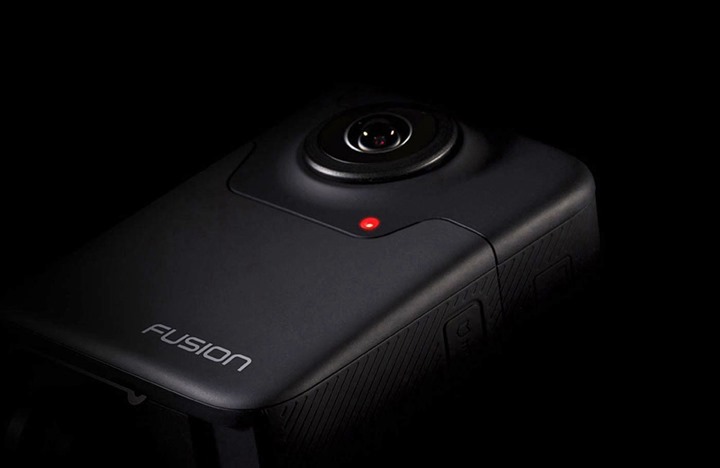
A few weeks ago GoPro sorta-announced a new action cam. Sorta being the operative word here. Unlike most GoPro announcement occurrences, this was more of a formalized naming and acknowledgment of existence. It included roughly as much information as an upcoming birth announcement, with about the same timelines and details. Yes, we know it’s a baby, and its gender. Oh, and it’ll be born sometime at the end of the year.
Which isn’t to say you can’t pick up a lot of nuances from what GoPro is doing based on what they’ve shown, and that’s what I want to dive into here. GoPro has long been in the 360° game, though only at the much higher professional level (to varying degrees). Those systems go for many thousands of dollars. In this case though, they’re likely aiming for the Prosumer market. By that, I mean that a camera with these specs (which we’ll get into in a moment), won’t likely be sub-$500, so it’s appeal to the everyday consumer is more limited.
And before we get too far – some will say that most 360° footage they’ve seen from other units sucks. And I agree, it mostly does. But there is potential. Partly with better units with higher resolution, and partly with people doing more interesting things with it. For example, with GoPro’s partnership with Velon I suspect we’ll see some 360° shots this year in the peloton at the Tour de France (or maybe even Giro) – which would be incredible on a sprint. Or you can look at some 360° footage shot by 360Fly in the cockpit of a fighter jet taking off a carrier. All of which are just a few examples of cool ways to use 360° cameras.
A Spec of Specs:
GoPro’s release of information was extremely limited. In total, it contains a mere four things:
A) A very short press release
B) A 2 minute sample video with a mere 6 cuts
C) A single computer generated partially obscured image of the device (above)
D) A single page website hosting A-C above.
That press release, in turn, provides very little data. In fact, the first sentence is actually all you need to read:
“Today announced a pilot program for GoPro Fusion, its 5.2K spherical camera designed to be the ultimate capture device for both fully immersive virtual reality content as well as conventional non-VR video and photo formats.”
The remainder of the press release is mostly just blah-blah hype explaining what a 360° camera is. However, there is this little snippet that’s worthy of discussion:
“In addition to high-performance spherical capture for fully immersive VR experiences, Fusion’s 5.2K resolution enables a new OverCapture creative solution that gives content creators the flexibility to produce conventional non-VR video and photos in HD-quality “punched out” from the spherically captured angles. Not just a VR capture solution, Fusion ensures that traditional content creators will get the shot, while also capturing the unexpected.”
What they’re basically saying here is that you can take snippets of the 360° video sphere and use it like you would a normal non-360° GoPro video. Of course, that feature is available on virtually every other 360° action camera platform already. It’s just that GoPro has decided to brand that ‘OverCapture’. Again, it’s just branding a feature that’s commonplace today.
Still, GoPro is the master of doing that. Take for example their ‘Linear’ mode on their new Hero5 cameras. That’s the same thing that others have been calling various terms like ‘remove fisheye’, which is all it does. But it’s brilliant because they can easily market it, and it’s something that sticks.
One benefit though of GoPro’s cutout here is that with the 5.2K resolution, their ‘punch out’ is essentially 1080p resolution. That’s a significant advantage over a normal 4K 360° action cam whose punch-out is a mere 720p resolution.
But let’s go back to the first technical snippet from earlier, which included the “5.2K” specification. That immediately tells us the minimum bar sensor types that GoPro is using. In all of GoPro’s existing cameras, they max out at a 4K camera. But with the Fusion, they’re clearly going with two lenses to achieve the full 360° sphere they note in their press release. As such, they’ll need at least two lenses. Doing any more lenses in a smaller camera wouldn’t really make much sense (compared to a pro rig). Within the single image provided, you can only see one side with one lens:
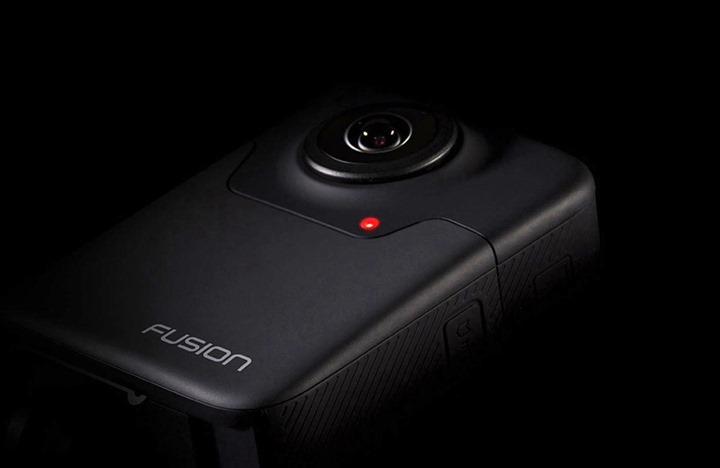
Though for fun, if I overexpose the image, you can see the semi-standard GoPro mode/highlight button, as well as likely some other button or port on the side, as well as what appears to be a GoPro style mount on the bottom:
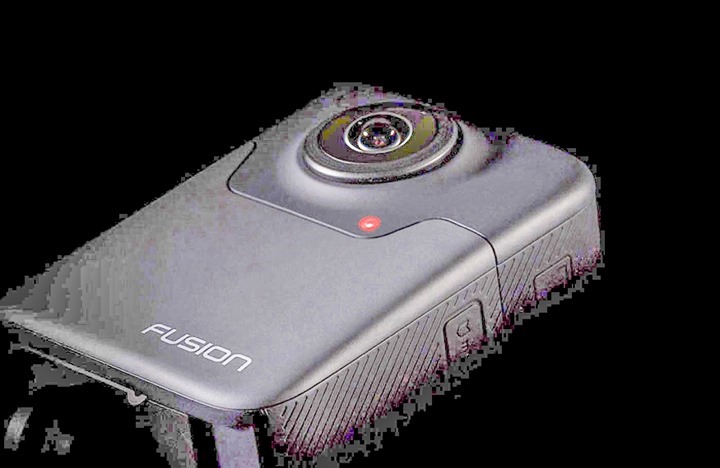
In any case, it’s a safe bet that GoPro is using two 4K cameras here, as are many others. For example, take a look at this 360Fly unit that was shown at CES this year, you can see the two cameras there. They used to do a single-camera 4K system, but their new one is dual-camera (+ screen atop). Interestingly, there’s virtually no mention of this setup on 360Fly’s site since CES. Also of note is that this system was set to be 4K in total, and thus substantially lower than GoPro’s plans.
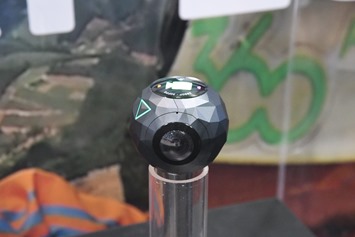
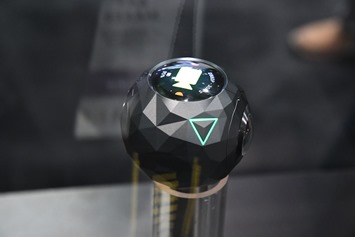
And that’s an important point to make. 5.2K is significantly more than 4K. Without knowing exactly what their resolutions are, let’s use the 5.2K resolution dimensions from the Inspire 2 as a rough ballpark. Those are 5280×2972, which gives you 15,692,160 or 15.7 MP.
Now compare that to 4K, which on a GoPro is 3840×2160 = 8,294,400 or 8.3MP. As you can see, 15.7MP is nearly double the existing 8.3MP on a standard 4K unit.
Now what’s also interesting here is that GoPro undershot slightly in specs compared to Yi’s new 360° action camera, the Yi 360, which was announced at NAB two weeks ago. That camera is doing 5.7K at 30FPS, which is 5760×2880 in pixels. Which comes in at 16,588,800 – or for those of you that are astute – exactly two 4K sensors (2×8,294,400).
Which brings up a good question – what is GoPro doing with the extra pixels? Or said another way: Why isn’t it a 5.7K unit? It’s highly unlikely GoPro is buying some wonky sub-4K combo and doubling it. So my guess is that either they’re using that overhead for some sort of stabilization or there’s some processing going on that reduces it.
Speaking of that Yi camera, that comes in at only $399USD, but that’s not really a realistic barometer of price for the GoPro or other units. While Yi is growing in popularity as an underdog, the reality is that most reviews tend to say it’s good – but not great. It’s not yet a GoPro. As such, it undercuts slightly on price. My guess is the GoPro Fusion will be $599-$799USD.

If we use the Yi camera as a general baseline, we’ll likely find many similar components and specs. For example, the Yi uses the Ambarella H2V95, and GoPro has a long history of using Ambarella chips. Next, we look at battery. Yi is claiming 75 minutes at 4K resolutions (though 60 minutes in another spot), which likely means even rougher battery life at 5.7K since that’s basically doubling the processing overhead.
And that’s one more point, most of the marketing Yi has shows that they’re doing 4K stitching (written as “4K/30fps Auto-Stitching”), but they walk a careful tightrope as at 5.7K (written as “5.7K/30fps video” and “professional-grade video quality at up to 5.7K/30fps in 360 degrees for post-production work”), which makes me believe they aren’t quite doing as impressive stuff as you might believe. Either way, I’ll likely pick one up to try it out.
Back on GoPro’s front, they did include a video sample, which is 2 mins and 1 second long. It’s essentially just six cuts long (a normal GoPro intro video would likely have a few hundred cuts), with six totally different scenes and little fancy camera work. Just simply a camera recording six different scenarios.
Scene 1: Wing suit in flat/cloudy lighting
Scene 2: Atop a commuter bike in San Francisco going down street
Scene 3: Kayaker in whitewater
Scene 4: A random grassy hillside with dogs
Scene 5: Parachuting skier
Scene 6: Lions on safari
Here’s the video:
Now there’s a few things that are notable in here:
Stitching: The stitching is pretty darn good. But I wouldn’t overthink that. In my experience with almost every 360° camera out there, I can easily find specific shots where the stitching is near perfect. It’s what the other times look like that’s important. Still, there are stitch lines; such can be seen in cases where the lighting makes it more obvious. For example, the hillside at 52 seconds you can see how the hillside horizons don’t match up just left of center:

But it’s actually pretty good on that same shot if you flip the camera around to what is likely the other stitch line, where the dogs are very close to the camera (trickiest part of stitch lines)

And the stitch is again visible (albeit just barely) in the winter scene, down the middle. In this case, the stitching itself actually looks pretty good, but rather the blend of exposures is what catches your eye (one lens is exposed just slightly differently than another).

Stabilization: They are definitely doing some stabilization, as you can see the warp effect easily in numerous places throughout the video. For example, at the 27-29 second marker as the bike hits bumps in the road. Or even more noticeable if you turn the camera away from the parachute and face the horizon during the winter scene. You’ll see significant wobbling there along the ridgelines and down into the snow. The real question though: Is this stabilization applied in post-production, or in the camera itself?

Sharpness/Image Quality: Simply put, the sharpness is awesome here. When the key item in the video is wholly on a single lens, such as with the lions, it’s brilliantly sharp. Looks awesome. And in this scene, it’s nearly impossible to pick out the stitch lines (it appears to be between the lions and the truck, as though one lens was facing each, you can barely make it out on a bush). Again, the lighting in this scene really helps.

Again, keep in mind that this is at its core, a marketing video. And thus GoPro is selecting the clips it believes shows off the camera the best, with the minimum number of things to nitpick. Just like Garmin, Sony, Yi, and everyone else does.
Going forward:
So when is it coming out? Well…not for a while. The press release ends by noting the following:
“This summer, GoPro will be working closely with a selection of pilot partners – including brands, agencies and content professionals – to further refine the user experience and produce inspiring content that demonstrates the creative potential of Fusion. GoPro plans a limited commercial release of Fusion by the end of 2017. Details on pricing and other specifics will be provided at launch.”
And this is where things are kinda weird. Why announce the most important spec of the product (the camera resolution) 6-7 months out and give all your competitors time to react? Rumor mill within the industry says that GoPro believed a leak was about to occur, and they wanted to get ahead of it.
That jibes fairly well with what we see here. A single computer generated image of the device, a few paragraph press release with a name, and then a quick 2-minute video snippet with likely stock footage they had lying around. All of which could be put together in a single morning by a company such as GoPro.
The challenge GoPro will have is avoiding a Karma-like product release. You’ll remember they announced Karma in almost a similar fashion with very little information up-front, and then many months of delays before a disappointing product release that was barely available (and then recall). Of course, action cameras are much easier than drones. And hopefully by engaging pilot testers this summer they’re able to work through those bugs early. Thus, it seems like they probably have learned some things from Karma (which they kept under incredible wraps till the last second).
Still – unlike drones which already had an undisputed market leader, 360 action cams don’t have such a clear winner. There are many companies playing in the field, and many of the cameras tend to suck – and even worse software. So if GoPro can insert itself as a hardware leader and compliment that with some at least half-way decent software – it might actually have a winner. Assuming the market agrees with the price of course.
All of which also ignores the Hero6 lineup that the company has previously announced in investor calls, which is coming later this year (probably in September/October like usual). That’ll add even more interest to the fall.
Looking forward to it!
With that – thanks for reading!


